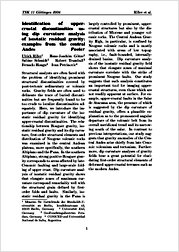Identification of uppercrustal discontinuities using dip curvature analysis of isostatic residual gravity: examples from the central Andes
2006Universitätsverlag Göttingen
Sammelband- / Konferenzbeitrag
Verlagsversion
Deutsch
Riller, Ulrich; Götze, Hans-Joachim; Schmidt, Sabine; Trumbull, Robert; Hongn, Fernado; Petrinovic, Ivan, 2006: Identification of uppercrustal discontinuities using dip curvature analysis of isostatic residual gravity: examples from the central Andes. In: Philipp, S.; Leiss, B; Vollbrecht, A.; Tanner, D.; Gudmundsson, A. (eds.): 11. Symposium "Tektonik, Struktur- und Kristallingeologie"; 2006, Univ.-Verl. Göttingen, p. 181 - 182., , DOI: 10.23689/fidgeo-1887.
 |
Dokument öffnen: |
Structural analysts are often faced with
the problem of identifying prominent
structural discontinuities covered by
post-tectonic sedimentary or volcanic
rocks. Gravity fields are often used to
delineate the trace of buried discontinuities
but are frequently found to be
too crude to localize discontinuities adequately.
Here, we introduce the importance
of dip curvature of the isostatic
residual gravity for identifying
upper-crustal discontinuities. The relationship
between Bouguer gravity, isostatic
residual gravity and its dip curvature,
first-order structural elements and
distribution of Neogene volcanic rocks
was examined in the central Andean
plateau, more specifically, the southern
Altiplano and the Puna...

